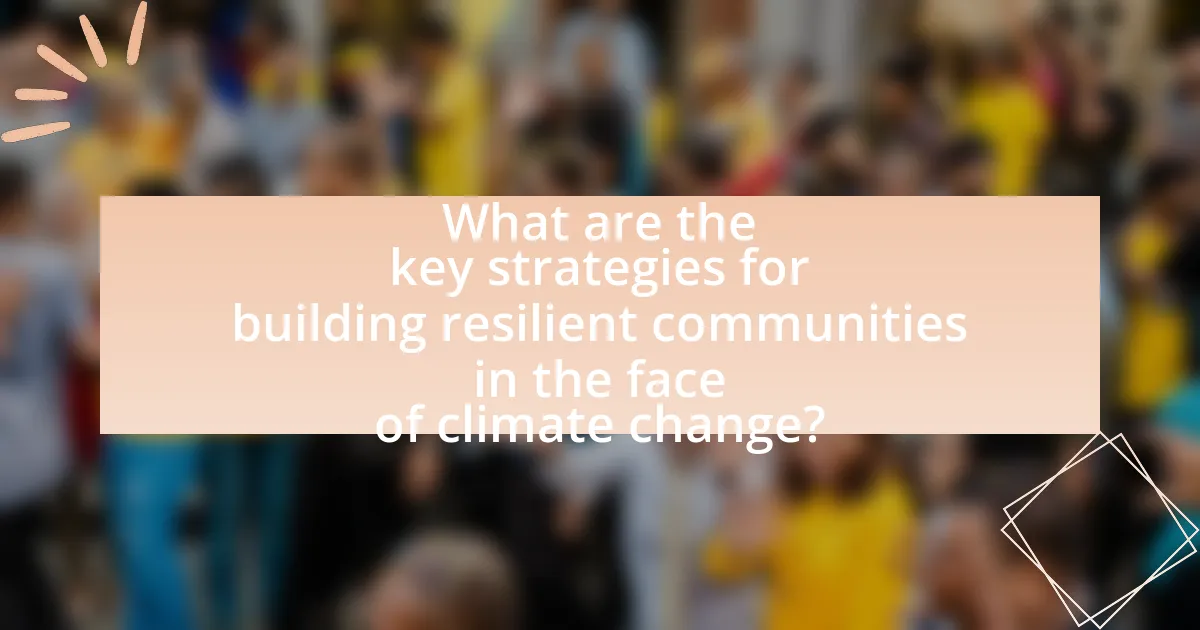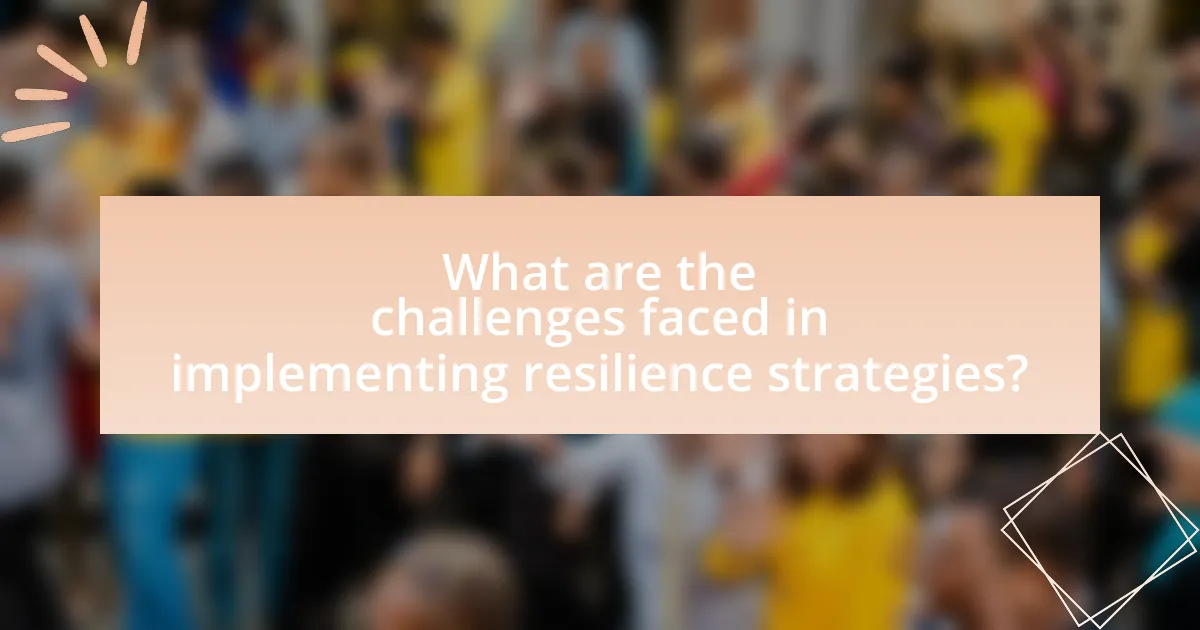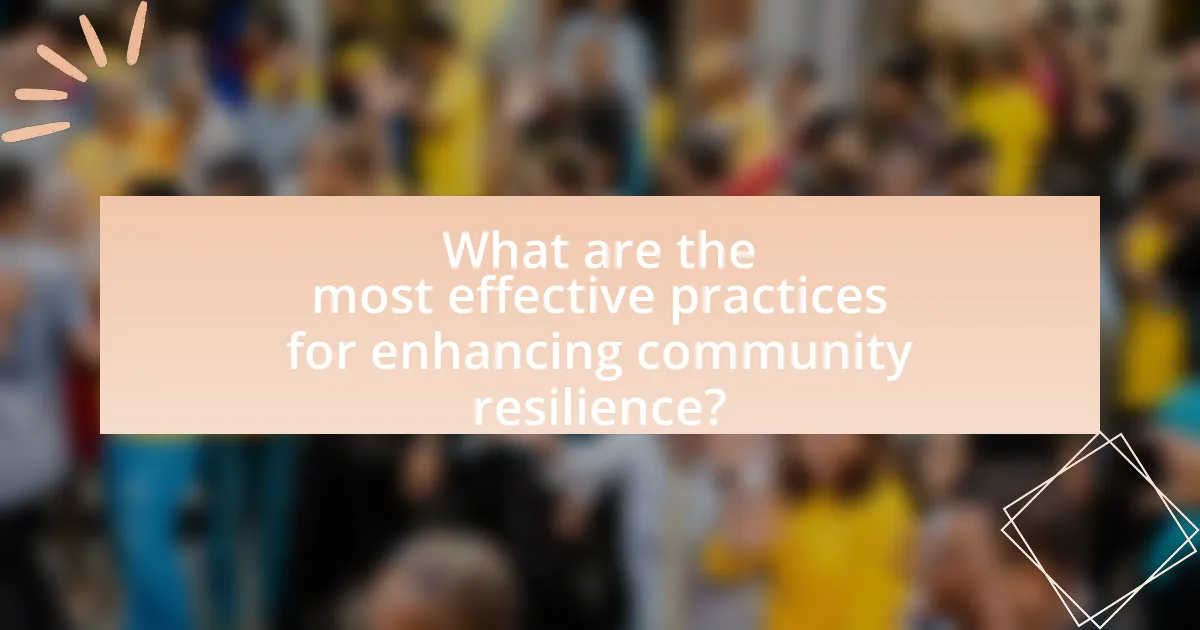The article focuses on strategies for building resilient communities in the face of climate change. It outlines key approaches such as enhancing local infrastructure, promoting sustainable practices, and fostering community engagement to improve adaptability and preparedness. The discussion includes methods for involving community members in resilience planning, the role of infrastructure in disaster response, and the importance of education and awareness campaigns. Additionally, it addresses challenges in implementing resilience strategies, the influence of economic factors, and the significance of inclusivity in decision-making processes. The article emphasizes practical steps and technological innovations that can enhance community resilience against climate impacts.

What are the key strategies for building resilient communities in the face of climate change?
Key strategies for building resilient communities in the face of climate change include enhancing local infrastructure, promoting sustainable practices, and fostering community engagement. Enhancing local infrastructure involves upgrading roads, bridges, and utilities to withstand extreme weather events, as evidenced by the Federal Emergency Management Agency’s guidelines which emphasize the importance of resilient infrastructure in disaster-prone areas. Promoting sustainable practices, such as implementing green building standards and encouraging renewable energy use, can reduce carbon footprints and improve community adaptability, supported by studies showing that sustainable communities are better equipped to handle climate impacts. Fostering community engagement through education and participatory planning ensures that residents are informed and involved in resilience efforts, which research from the National Institute of Standards and Technology indicates leads to more effective and tailored responses to climate challenges.
How can community engagement enhance resilience against climate change?
Community engagement enhances resilience against climate change by fostering collaboration, knowledge sharing, and local action. Engaged communities are better equipped to identify vulnerabilities and develop tailored strategies to address climate impacts. For example, a study by the National Oceanic and Atmospheric Administration (NOAA) found that communities actively involved in climate adaptation planning reported increased awareness and preparedness, leading to more effective responses during climate-related events. This collaborative approach not only strengthens social ties but also mobilizes resources and expertise, ultimately resulting in more sustainable and resilient communities.
What methods can be used to involve community members in resilience planning?
Community engagement methods in resilience planning include participatory workshops, surveys, and community forums. Participatory workshops allow community members to collaborate on identifying local vulnerabilities and developing solutions, fostering a sense of ownership and commitment. Surveys can gather diverse opinions and insights from a broader audience, ensuring that various perspectives are considered in the planning process. Community forums provide a platform for open dialogue, enabling residents to voice concerns and share experiences, which can inform resilience strategies. Research indicates that involving community members in these ways enhances the effectiveness of resilience planning by aligning strategies with local needs and priorities.
How does community participation influence decision-making processes?
Community participation significantly enhances decision-making processes by ensuring that diverse perspectives and local knowledge are integrated into planning and implementation. This inclusion leads to more relevant and effective solutions, as evidenced by case studies where community-driven initiatives have resulted in improved disaster preparedness and resource management. For instance, the 2015 Nepal earthquake response highlighted how local involvement in recovery efforts led to faster and more culturally appropriate rebuilding strategies. Such examples demonstrate that when communities actively participate, decisions are more likely to reflect the actual needs and priorities of the population, ultimately fostering resilience in the face of climate change.
What role does infrastructure play in community resilience?
Infrastructure is crucial for community resilience as it provides the essential services and systems that enable communities to withstand and recover from adverse events. Effective infrastructure, such as transportation networks, utilities, and communication systems, enhances a community’s ability to respond to disasters, ensuring access to resources and support. For instance, studies show that communities with robust infrastructure can recover from natural disasters more quickly; the National Institute of Building Sciences reports that every dollar invested in disaster mitigation infrastructure can save society six dollars in recovery costs. This demonstrates that well-planned infrastructure not only supports immediate response efforts but also contributes to long-term resilience by reducing vulnerability and enhancing adaptive capacity in the face of climate change.
How can sustainable infrastructure reduce vulnerability to climate impacts?
Sustainable infrastructure reduces vulnerability to climate impacts by integrating resilient design principles that enhance adaptability and resource efficiency. For instance, green roofs and permeable pavements mitigate urban flooding by absorbing rainwater, thereby decreasing runoff and the risk of waterlogging. Additionally, renewable energy systems, such as solar panels and wind turbines, provide reliable energy sources that are less susceptible to disruptions caused by extreme weather events. Research from the National Institute of Building Sciences indicates that investing in resilient infrastructure can save communities up to $4 for every $1 spent on mitigation efforts, demonstrating the economic benefits of such strategies.
What are the best practices for retrofitting existing infrastructure?
The best practices for retrofitting existing infrastructure include conducting thorough assessments, prioritizing energy efficiency, utilizing sustainable materials, and integrating advanced technologies. Conducting assessments helps identify vulnerabilities and areas needing improvement, ensuring that retrofitting efforts are targeted and effective. Prioritizing energy efficiency can reduce operational costs and greenhouse gas emissions, as evidenced by studies showing that energy-efficient retrofits can lead to energy savings of 20-50%. Utilizing sustainable materials minimizes environmental impact and enhances durability, while integrating advanced technologies, such as smart sensors and automation, improves monitoring and management of infrastructure systems. These practices collectively contribute to building resilient communities capable of withstanding climate change impacts.
Why is education important for fostering resilience in communities?
Education is crucial for fostering resilience in communities because it equips individuals with the knowledge and skills necessary to adapt to challenges, including those posed by climate change. By providing education on environmental issues, communities can develop a better understanding of risks and implement effective strategies for mitigation and adaptation. Research indicates that educated communities are more likely to engage in proactive measures, such as sustainable practices and disaster preparedness, which enhance their overall resilience. For instance, a study by the United Nations Educational, Scientific and Cultural Organization (UNESCO) highlights that education increases awareness and promotes critical thinking, enabling communities to respond effectively to climate-related threats.
What educational programs can empower communities to adapt to climate change?
Educational programs that can empower communities to adapt to climate change include climate literacy initiatives, community-based adaptation training, and sustainable agriculture education. Climate literacy initiatives, such as those developed by the National Oceanic and Atmospheric Administration (NOAA), provide essential knowledge about climate science and its impacts, enabling individuals to make informed decisions. Community-based adaptation training programs, like those offered by the United Nations Development Programme (UNDP), equip local leaders with skills to assess vulnerabilities and implement adaptive strategies tailored to their specific contexts. Sustainable agriculture education, exemplified by programs from organizations like the Food and Agriculture Organization (FAO), teaches farmers techniques that enhance resilience to climate variability, such as crop diversification and water management practices. These educational efforts collectively enhance community resilience by fostering knowledge, skills, and adaptive capacities necessary for effective climate change adaptation.
How can awareness campaigns increase community preparedness?
Awareness campaigns can increase community preparedness by educating residents about potential climate-related risks and promoting proactive measures. These campaigns provide critical information on emergency protocols, resource availability, and risk mitigation strategies, enabling communities to respond effectively to climate events. For instance, a study by the National Oceanic and Atmospheric Administration (NOAA) found that communities with active awareness campaigns experienced a 30% increase in emergency preparedness actions among residents. This demonstrates that informed communities are better equipped to handle climate challenges, ultimately enhancing their resilience.

What are the challenges faced in implementing resilience strategies?
The challenges faced in implementing resilience strategies include funding limitations, lack of stakeholder engagement, and insufficient data for informed decision-making. Funding limitations hinder the ability to develop and sustain resilience initiatives, as many communities struggle to secure necessary financial resources. Lack of stakeholder engagement often results in insufficient community buy-in, which is crucial for the success of resilience strategies. Additionally, insufficient data can impede the assessment of vulnerabilities and the effectiveness of proposed strategies, making it difficult to tailor interventions to specific community needs. These challenges collectively undermine the effectiveness of resilience strategies aimed at addressing climate change impacts.
How do economic factors affect the ability to build resilient communities?
Economic factors significantly influence the ability to build resilient communities by determining the availability of resources for infrastructure, social services, and emergency preparedness. Communities with strong economic foundations can invest in sustainable practices, such as green infrastructure and renewable energy, which enhance resilience against climate change impacts. For instance, a study by the National Institute of Building Sciences found that every dollar invested in disaster mitigation can save society an average of six dollars in future disaster costs. This demonstrates that economic investment directly correlates with improved community resilience, as it enables proactive measures rather than reactive responses to climate-related challenges.
What funding sources are available for resilience projects?
Funding sources available for resilience projects include federal grants, state funding programs, private foundations, and public-private partnerships. Federal grants such as those from the Federal Emergency Management Agency (FEMA) and the National Oceanic and Atmospheric Administration (NOAA) specifically target resilience initiatives. Additionally, state governments often allocate funds for local resilience projects through various environmental and disaster preparedness programs. Private foundations, like the Rockefeller Foundation, also provide financial support for innovative resilience strategies. Public-private partnerships can leverage resources from both sectors to enhance community resilience against climate change impacts.
How can communities prioritize resilience initiatives within budget constraints?
Communities can prioritize resilience initiatives within budget constraints by conducting a thorough assessment of vulnerabilities and identifying cost-effective solutions. This approach allows communities to focus on high-impact projects that address the most pressing risks, such as flooding or extreme heat, while maximizing the use of limited financial resources. For instance, the National Institute of Building Sciences reports that every dollar invested in disaster mitigation can save society an average of six dollars in future disaster costs. By leveraging existing data, engaging stakeholders, and seeking funding from grants or partnerships, communities can effectively implement resilience strategies that align with their budgetary limitations.
What social barriers hinder the development of resilient communities?
Social barriers that hinder the development of resilient communities include socioeconomic inequality, lack of social cohesion, and inadequate access to resources. Socioeconomic inequality creates disparities in wealth and opportunities, limiting the ability of marginalized groups to participate in community resilience efforts. Lack of social cohesion, characterized by weak relationships and trust among community members, impedes collective action necessary for resilience. Inadequate access to resources, such as education, healthcare, and financial support, further exacerbates vulnerabilities, making it difficult for communities to adapt to and recover from climate-related challenges. These barriers collectively undermine the capacity of communities to build resilience in the face of climate change.
How can inclusivity be promoted in resilience planning?
Inclusivity can be promoted in resilience planning by actively engaging diverse community stakeholders in the decision-making process. This approach ensures that the perspectives and needs of marginalized groups are considered, leading to more equitable and effective resilience strategies. Research shows that inclusive planning processes enhance community trust and participation, which are critical for successful implementation. For instance, the National Oceanic and Atmospheric Administration (NOAA) emphasizes the importance of stakeholder engagement in their resilience planning guidelines, highlighting that inclusive practices lead to better outcomes in disaster preparedness and recovery.
What strategies can address disparities in community resilience?
Strategies to address disparities in community resilience include enhancing access to resources, fostering inclusive decision-making, and building local capacity. Enhancing access to resources involves ensuring that marginalized communities receive adequate funding, training, and support for disaster preparedness and recovery. For example, the Federal Emergency Management Agency (FEMA) has programs aimed at increasing funding for low-income areas to improve infrastructure and emergency services.
Fostering inclusive decision-making ensures that all community members, particularly those from disadvantaged backgrounds, have a voice in resilience planning. Research shows that communities with diverse stakeholder engagement are better equipped to identify unique vulnerabilities and develop tailored solutions.
Building local capacity involves training community leaders and organizations to implement resilience strategies effectively. Studies indicate that communities with strong local leadership and networks are more successful in mobilizing resources and responding to crises. These strategies collectively contribute to reducing disparities in community resilience, ultimately leading to more equitable outcomes in the face of climate change.

What are the most effective practices for enhancing community resilience?
The most effective practices for enhancing community resilience include fostering social networks, implementing sustainable infrastructure, and promoting adaptive governance. Fostering social networks strengthens community ties, enabling individuals to support each other during crises, as evidenced by studies showing that communities with strong social cohesion recover more quickly from disasters. Implementing sustainable infrastructure, such as green roofs and permeable pavements, reduces vulnerability to climate impacts and enhances environmental health, supported by research indicating that such measures can lower urban heat and manage stormwater effectively. Promoting adaptive governance involves engaging community members in decision-making processes, which has been shown to lead to more effective and inclusive responses to climate challenges, as highlighted in the “Community Resilience Framework” by the National Institute of Standards and Technology.
How can local governments support resilience-building efforts?
Local governments can support resilience-building efforts by implementing policies that promote sustainable development and disaster preparedness. These policies can include investing in infrastructure improvements, such as flood defenses and green spaces, which enhance community resilience against climate-related events. For instance, the National Oceanic and Atmospheric Administration (NOAA) reported that communities with robust infrastructure are better equipped to withstand extreme weather, reducing recovery costs by up to 50%. Additionally, local governments can facilitate community engagement through workshops and training programs that educate residents on emergency preparedness and climate adaptation strategies. This approach not only empowers citizens but also fosters a collaborative environment for resilience planning.
What policies can be enacted to promote sustainable practices?
Policies that can be enacted to promote sustainable practices include implementing carbon pricing mechanisms, enhancing renewable energy incentives, and enforcing stricter regulations on waste management. Carbon pricing, such as a carbon tax or cap-and-trade system, encourages businesses to reduce emissions by making it financially beneficial to adopt cleaner technologies. For instance, countries like Sweden have successfully reduced greenhouse gas emissions by over 25% since implementing a carbon tax in 1991. Renewable energy incentives, such as tax credits and subsidies for solar and wind energy, can accelerate the transition to sustainable energy sources, as seen in Germany’s Energiewende initiative, which has significantly increased renewable energy’s share in the national energy mix. Stricter waste management regulations, including mandatory recycling and composting programs, can reduce landfill waste and promote circular economy practices, as evidenced by San Francisco’s zero waste goal, which has achieved a diversion rate of over 80%.
How can partnerships with NGOs enhance community resilience initiatives?
Partnerships with NGOs can enhance community resilience initiatives by leveraging specialized expertise, resources, and networks that NGOs possess. NGOs often have experience in disaster response, community engagement, and sustainable development, which can be crucial for designing effective resilience strategies. For instance, a study by the International Federation of Red Cross and Red Crescent Societies found that communities engaged with NGOs during disaster preparedness training showed a 30% increase in resilience metrics compared to those that did not participate. This demonstrates that NGOs can provide essential training and support, facilitating knowledge transfer and empowering local populations to better prepare for and respond to climate-related challenges.
What role does technology play in building resilient communities?
Technology plays a crucial role in building resilient communities by enhancing communication, improving resource management, and facilitating data-driven decision-making. For instance, advanced communication technologies enable real-time information sharing during emergencies, which can significantly reduce response times and improve coordination among community members and first responders. Additionally, technologies such as Geographic Information Systems (GIS) allow communities to analyze environmental data, identify vulnerabilities, and plan for climate-related challenges effectively. Research from the National Academies of Sciences indicates that communities utilizing technology for disaster preparedness and response can reduce recovery times by up to 30%. This demonstrates that technology not only supports immediate response efforts but also fosters long-term resilience against climate change impacts.
How can data and analytics inform resilience strategies?
Data and analytics can inform resilience strategies by providing actionable insights that enhance decision-making and resource allocation in response to climate change. For instance, geographic information systems (GIS) can analyze spatial data to identify vulnerable areas, enabling targeted interventions. Additionally, predictive analytics can forecast climate-related risks, such as flooding or heatwaves, allowing communities to prepare and adapt proactively. A study by the National Oceanic and Atmospheric Administration (NOAA) highlights that data-driven approaches can improve emergency response times by up to 30%, demonstrating the effectiveness of analytics in enhancing community resilience.
What technological innovations are most beneficial for community resilience?
Technological innovations that are most beneficial for community resilience include smart grid technology, early warning systems, and sustainable urban planning tools. Smart grid technology enhances energy efficiency and reliability, allowing communities to better manage resources during crises. Early warning systems utilize data analytics and real-time monitoring to provide timely alerts for natural disasters, significantly reducing response times and potential damage. Sustainable urban planning tools, such as Geographic Information Systems (GIS), enable communities to assess vulnerabilities and design infrastructure that can withstand climate impacts. These innovations collectively strengthen community preparedness and adaptability in the face of climate change.
What practical steps can communities take to improve their resilience?
Communities can improve their resilience by implementing comprehensive disaster preparedness plans. These plans should include risk assessments to identify vulnerabilities, community training programs for emergency response, and the establishment of communication networks to disseminate information during crises. For instance, the National Institute of Building Sciences reports that communities with well-prepared emergency plans can reduce disaster recovery costs by up to 40%. Additionally, fostering local partnerships with organizations and stakeholders enhances resource sharing and support during emergencies, further strengthening community resilience.